German Army Artillery & Ordnance Officer's Dress Tunic
CATEGORY: Version
SKU: 20.GOR.02.01.01.01.02.002.000
Estimated market value:
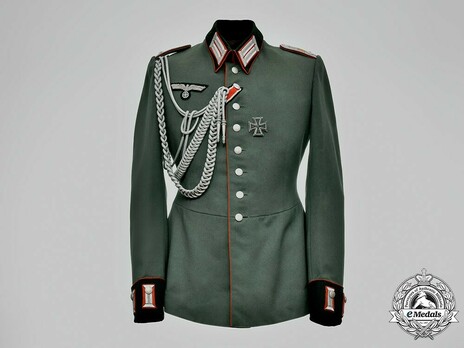
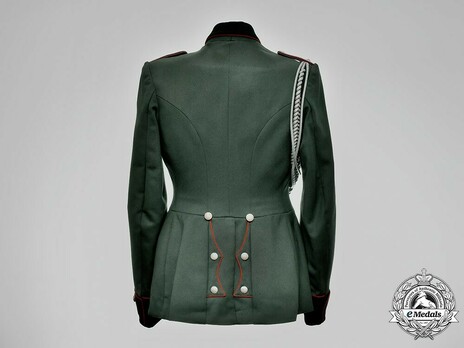
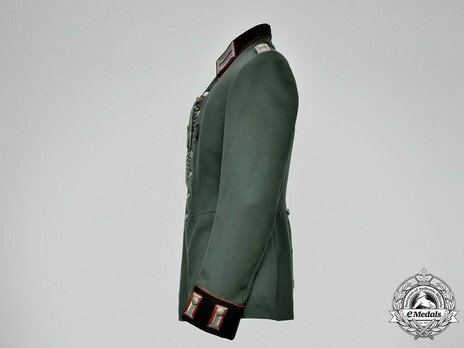
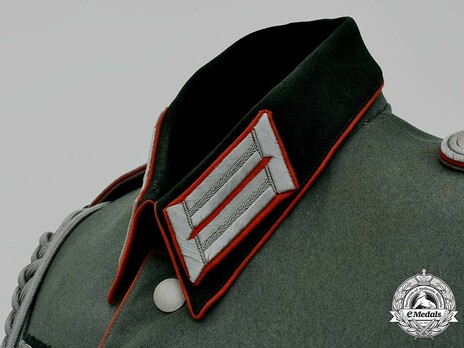
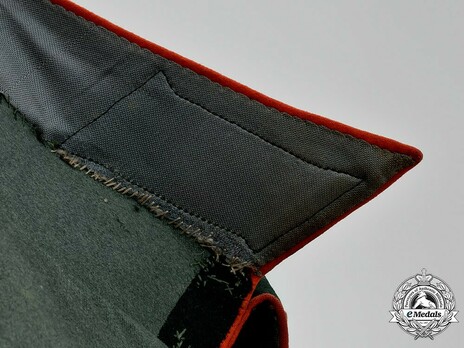
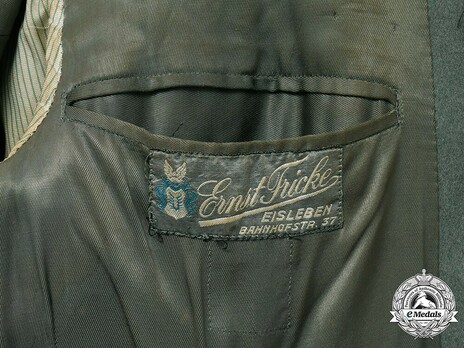
Estimated market value:
Heer (Army) Artillery Waffenrock tunic. It is constructed of medium grain field-grey herringbone pattern wool, with dark green collars. It is piped in red, denoting artillery, along its collar, tunic flap, and cuffs, and is adorned with Oberleutnant rank shoulder boards. The boards are that of the sew-on type, constructed of four rows of tightly intertwined silver aluminum bullion wire in a “U” formation, with a button hole, red piping, a single silvered aluminum rank pip, as well as a gilded “14” unit number, all fastened to the uniform via a single silvered pebbled aluminum button. The collar is adorned with standard officer’s collar tabs, constructed of equally fine quality silver aluminum bullion wire with red piping. The cuffs feature similar, but smaller tabs, two per cuff, along with a silvered pebbled aluminum button on fastened to each tab. There is a dual hook and eye at the opening of the collar, ensuring a snug fit at the neck line. This Waffenrock does not have frontal pockets, but a standard issue officer’s bullion eagle still adorns the right chest, directly above where a pocket usually sits, constructed of twisted, rolled, and flat silver bullion wire, interlaced with threading to give definition to the wings and wrath, on a hunter green wool base. Along the opening of this tunic are eight vertically oriented silver aluminum bullion buttons, marked “C. Th. Dicke” on the reverse, facing an equal number of reinforced button holes on the other side. Protruding from the second button hole from the top is an Iron Cross 1939 Second Class ribbon, sewn in place on the underside of the opening. The right chest is decorated with an Iron Cross 1939 First Class; a cross pattée of multi-piece construction with a blackened iron core (magnetic) within a ribbed border; the obverse with a raised central mobile swastika with the re-institution date “1939” in raised numbering on the lower arm; the reverse plain, with a slender banjo style vertical pinback, a barrel hinge, and a unique two-prong catch; marked “26” for “B.H. Mayer’s Kunstprägeanstalt” on the reverse; measuring 44.35 mm (w) x 44.19 mm (h); weighing 17.7 grams. The Iron Cross was forcefully pushed through the fabric, and was not attached using typical award loops found on other second war German uniforms. Suspended from the right shoulder is a well preserved Wehrmacht aiguillette; constructed of silver bullion wire wrapped around a white cotton core, divided into two sections - one section of a cord braided into multiple rows of loops - the second section with a slightly longer looped cord with a braided aluminum wire adjustment know, with both joined at a single button-hole patch constructed of silver bullion wire, with two silvered zink tips attached to the aiguillette. The interior of this Waffenrock is lined in in olive green fabric, with a belt hook and clasp protruding from the interior of the tunic, with lined sleeves in a white striped pattern. On left side of the interior is a small horizontal slit pocket, with a maker’s tag sewn into the fabric directly below, reading “Ernst Fricke, Eisleben, Bahnhofstr. 37”. It measures 45 cm across the shoulders, with 67 cm long sleeves, and with a total length of 80 cm. Light mothing evident from storage, but in overall near mint condition.
The Dress Tunic was introduced on June 29, 1935. It was worn by all members of the Heer during parades and ceremonial occasions, and as a walking-out dress.
The tunic is field-grey with a dark blue-green collar and dark blue-green cuff-facings, and has branch colour piping down the edge of the front overlap, down the front edge of the collar and around the collar base, on the upper edges of the cuff-facings, and down the two tunic flaps in the back.
The collar has a stand-up and fall-down part. There are eight silver-white metal buttons down the front. Three more buttons are attached to each of the two tunic flaps on the back, and one non-functional button to each of the four cuff-facing patches. General ranks had gold-coloured buttons.
The tunic has no pockets, except for two hidden pockets in the tunic tail.
Tunics for higher ranked soldiers are generally made from materials of superior quality. There are four different rank segments wearing slightly but distinctively different tunics: EMs (enlisted men), NCOs (non-commissioned officers), officers, and generals. General rank tunics can be identified not only by the gilt buttons, but also the ornate gilt embroideries on their cuff and collar patches. All other ranks had so-called Litzen (flat braid) on their cuff and collar patches. Those of officers were made of superior quality material and are more elaborate in design compared to the rather plain ones of EMs and NCOs. The difference between EM and NCO tunics lies in another type of flat braid, so-called Tresse (trimming), along the edges of the cuffs and collars, similar to those on NCO rank shoulder straps.
Tunic insignia, such as breast eagles, collar tabs, or shoulder boards will differ from rank to rank. For more information, see the appropriate entries in the Insignia subcategory.
Production of the dress tunic was discontinued with the outbreak of the war.
A special version was introduced on September 15, 1939 for members of the Infantry Regiment “Großdeutschland”. It has white piping and white metal buttons. The collar Litzen are elongated. Officer tunics have two collar Litzen, while those for EMs and NCOs only have one. There are three cuff-patches per cuff, which are of the so-called “French” cuff patterns.
Only very few jackets were ever given out due to the outbreak of the war, and it was never manufactured in great numbers.
Chaplains wore an Überrock (frock coat) in place of the Dress Tunic. For more information, see the Coats subcategory.
Branch colours on German Heer headgear was as follows:
Black was worn by Engineer units.
Black/White was worn by Panzer Engineers.
Copper Brown was worn by Motorcycle personnel.
Light Brown was worn by Signals units until 1936, and by Construction troops.
Carmine was worn by the Führer Staff, General Staff Officers, Staff Officers of the Supreme Command of the Army, and all Veterinary branches.
Bordeaux Red was worn by Smoke & Chemical personnel.
Wine Red was worn by Judicial officials.
Bright Red was worn by Generals, Artillery units, and Ordnance Officers (until 1944).
Rose or Pink was worn by all Armored units (including Panzer troops, and Schützen Brigade Staff).
Orange was worn by Recruiting personnel, Ordnance troops, Ordnance Officers (since 1944), and Field Gendarmerie units.
Bright yellow was worn by Cavalry units, and Light Division Staff.
Lemon yellow was worn by Signal units.
White was worn by Infantry units.
Light Grey was worn by Propaganda personnel.
Grey-Blue was worn by Sonderführer (Specialist Officers).
Violet was worn by Chaplains and Field Bishops.
Cornflower Blue was worn by Medical units, and Supply units.
Bright Blue was worn by Transport troops.
Bright Green was worn by Jäger and Mountain units.
Grass Green was worn by Panzer Grenadier units (Armored Infantry).
Dark Green was worn by Administrative personnel.

Comments
Sign in to comment and reply.


Scroll Top